Arabidopsis AtPLC2 Is a Primary Phosphoinositide-Specific Phospholipase C in Phosphoinositide Metabolism and the Endoplasmic Reticulum Stress Response
Plant growth requires continuous signal transduction in response to ever-changing environment. Phosphoinositides represent primary lipid-derived signals that are involved in various plant responses to surrounding environment. However, enzymes that determine the complex phosphoinositide molecular profiles remained elusive due to the existence of a number of candidate genes for each step. Here, in Arabidopsis thaliana, we found AtPLC2 as the enzyme that is decisive in phosphoinositide metabolism by analytical lipidomics of the gene knockout study. Functional characterization of AtPLC2 knockout plant enabled us to find two novel roles of phosphoinositides: requirement in seedling growth and ER stress tolerance. Because economically important environmental stresses such as salinity and temperature upshift cause ER stress, our findings may open up a new avenue in addressing ER stress responses via phosphoinositide signaling.
Published in the journal:
Arabidopsis AtPLC2 Is a Primary Phosphoinositide-Specific Phospholipase C in Phosphoinositide Metabolism and the Endoplasmic Reticulum Stress Response. PLoS Genet 11(9): e32767. doi:10.1371/journal.pgen.1005511
Category:
Research Article
doi:
https://doi.org/10.1371/journal.pgen.1005511
Summary
Plant growth requires continuous signal transduction in response to ever-changing environment. Phosphoinositides represent primary lipid-derived signals that are involved in various plant responses to surrounding environment. However, enzymes that determine the complex phosphoinositide molecular profiles remained elusive due to the existence of a number of candidate genes for each step. Here, in Arabidopsis thaliana, we found AtPLC2 as the enzyme that is decisive in phosphoinositide metabolism by analytical lipidomics of the gene knockout study. Functional characterization of AtPLC2 knockout plant enabled us to find two novel roles of phosphoinositides: requirement in seedling growth and ER stress tolerance. Because economically important environmental stresses such as salinity and temperature upshift cause ER stress, our findings may open up a new avenue in addressing ER stress responses via phosphoinositide signaling.
Introduction
The phosphoinositides are phosphorylated derivatives of phosphatidylinositol, which represent a minor portion of phospholipids but a major role in lipid signaling from bacteria to seed plants or mammals [1]. The final step of phosphoinositide metabolism is the hydrolysis of phosphatidylinositol 4,5-bisphosphate [PI(4,5)P2] into inositol 1,4,5-trisphosphate (IP3) and sn-1,2-diacylglycerol (DAG) that is catalyzed by phospholipase C (PLC) (Fig 1A). This reaction is a crucial step in achieving signal transduction: IP3 triggers Ca2+ influx and DAG kinase readily converts DAG to phosphatidic acid (PA), which serves as a lipid second messenger to fulfill distinct roles of signal transduction in plants [2]. Therefore, investigating function of PLC has utmost importance in understanding the entire phosphoinositide signaling.
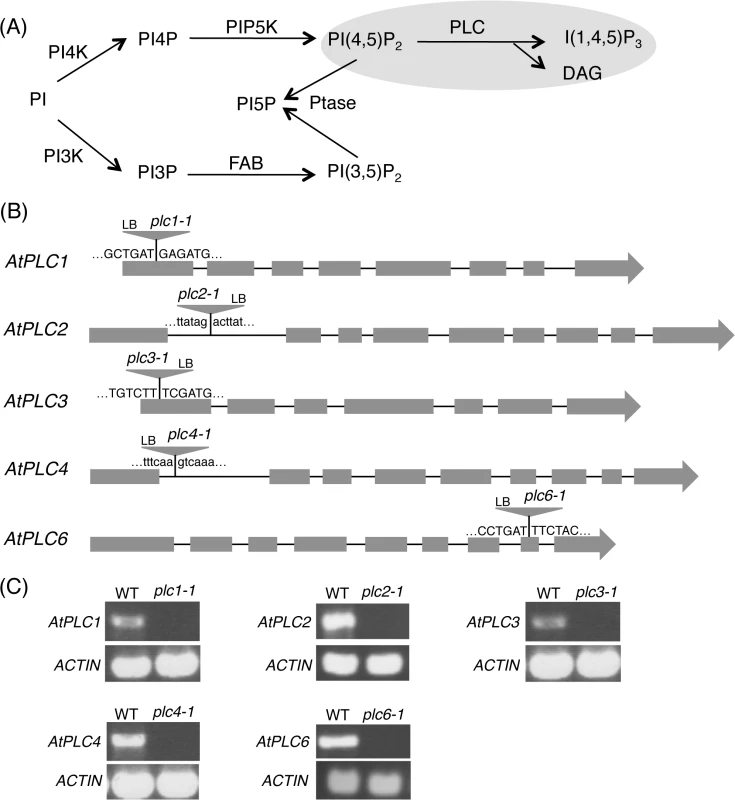
Two types of PLC are known in Arabidopsis: non-specific PLC (NPC), which hydrolyzes abundant phospholipids such as phosphatidylcholine (PC), phosphatidylethanolamine; and phosphoinositide-specific PLC (PI-PLC), which is specific to PI(4,5)P2 and its related derivatives [3]. The NPC family has six isoforms, NPC1 to NPC6. For example, NPC4 and NPC5 are involved in membrane lipid remodeling in response to phosphate starvation [3,4]. On the other hand, nine genes are annotated as Arabidopsis PI-PLC, designated AtPLC1 to AtPLC9 [5,6]. AtPLCs are involved in broad range of stress-induced lipid signaling [1,7]. A majority of the AtPLC genes are transcriptionally induced by various environmental stimuli such as salt, cold and dehydration [7–11]. AtPLC1 (At5g58670) is induced by dehydration and salt stress [7,8]. AtPLC3 (At4g38530) is required for the secondary response to abscisic acid signaling [9], and AtPLC9 (At3g47220), together with AtPLC3, is involved in thermotolerance [10,11]. On the other hand, AtPLC2 (At3g08510) is constitutively expressed even under environmental stresses [7,12]. Although much progress has been made in understanding of involvement of AtPLC genes in environmental stress responses, we still do not know which of the nine AtPLC isoforms plays a major role in phosphoinositide metabolism.
At the cellular level, environmental stimuli such as salt and heat stresses induce ER stresses [13,14], which are caused by accumulation of aberrant proteins in the ER. To cope with the ER stress, eukaryotic cells have evolved multiple conserved strategies, termed ER quality control. The ER quality control system consists of the unfolded protein response (UPR) [15–17], ER-associated degradation (ERAD) [18–20], and the translational attenuation [21]. The system monitors the folding status of newly synthesized proteins in the secretory pathway, thereby allowing only correctly folded proteins to advance from the ER to their final destinations [22]. When aberrant proteins are accumulated in the ER, cells activate the UPR pathway to recover folding processes by increasing folding capacity. Concurrently, cells are able to suppress protein translation to reduce the loading of newly synthesized proteins into the ER [21]. Nevertheless, ultimately misfolded proteins are sorted and degraded to diminish their potential toxicity via the ERAD pathway [19,20]. Recent studies of ER quality control in plants showed that the underlying mechanisms are highly similar to those in mammals and yeasts in terms of UPR and ERAD pathways [23–26]. Environmental stresses such as salt or heat up-regulate most of AtPLC genes expression [7], and these stresses concurrently generate the ER stress in Arabidopsis [25]. However, a connection between phosphoinositide signaling and ER stress response remains unknown. Given that the ER is the major site of phospholipid biosynthesis, the phospholipid signaling may well be associated with ER function [27]. Thus, involvement of lipid signaling in ER stress response is an emerging issue in plants.
In this study, we isolated and analyzed knockout mutants of multiple AtPLC isoforms in Arabidopsis. Lipidomic profiling of phosphoinositides in the mutants showed that AtPLC2 is a primary PI-PLC in phosphoinositide metabolism. AtPLC2 protein is highly expressed in trichomes of young rosettes, young floral buds and vascular tissues of leaves, petals and roots. Subcellular localization study showed that AtPLC2 is found in the plasma membranes in different cell types. A knockout mutant plc2-1 showed seedling growth defects. Furthermore, the plc2-1 mutant showed enhanced susceptibility to stress affecting ER homeostasis. Thus, AtPLC2 is a major PI-PLC affecting phosphoinositide levels and ER stress tolerance.
Results
Isolation of PI-PLC mutants in Arabidopsis
To determine the primary AtPLC isoform in phosphoinositide metabolism, we first attempted to obtain T-DNA mutants for nine AtPLC isoforms and analyzed their phosphoinositide profiles. Although mutants for AtPLC5 (At5g58690), AtPLC7 (At3g55940), AtPLC8 (At3g47290) and AtPLC9 (At3g47220) were not available from public seed libraries, homozygous mutants were isolated for the other isoforms. Nomenclature of AtPLC genes follows those defined by Mueller-Roeber and Pical (2002) and Hunt et al. (2004) [5,6]. The positions of T-DNA insertion were confirmed by PCR-based sequencing, which were all located within the protein coding sequence of relevant genes (Fig 1B). The full-length transcript was not detected in any of the mutants, which confirmed that they are all null mutants (Fig 1C). Thus, the single mutants of these PI-PLC isoforms are viable.
Differential gene expression pattern of AtPLC genes
To examine differential gene expression profiles of AtPLC genes whose mutants were obtained in Fig 1, we utilized the publicly available gene expression database (GENEVESTIGATOR; www.genevestigator.com). Data for AtPLC6 were not available. We found differential expression patterns of these four AtPLC genes during plant growth and development (Fig 2A); AtPLC2 had the highest expression level of the four isoforms consistently throughout the development. While AtPLC3 and AtPLC4 showed stable expression pattern as well, AtPLC1 expression was increased during vegetative growth, remained high during flower development but was dramatically decreased along with senescence. Regarding tissue-specificity, AtPLC2 expressed rather ubiquitously in most of tissues except roots including primary root and root tip (Fig 2B). However, the other isoforms have clearer tissue specificity; AtPLC1 at stele, AtPLC3 at the shoot apex, abscission zone and hypocotyl, and AtPLC4 in male reproductive parts of flowers. These data suggest that AtPLC2 is the primarily and ubiquitously expressed isoform.
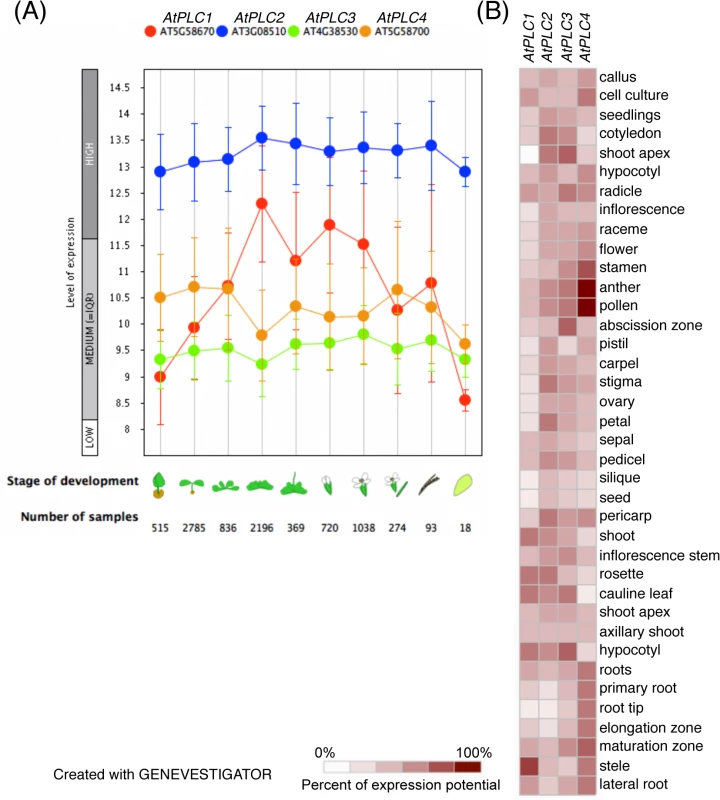
Altered phosphoinositide content in the plc2-1 mutant
To investigate which AtPLC isoform has major contribution to the phosphoinositide metabolism, we performed lipidomic analysis and quantified the phosphoinositide levels of the AtPLC mutants (Fig 3). Among the five AtPLC mutants isolated, only the plc2-1 mutant showed a 2.5-fold increase in level of phosphatidylinositol 4-phosphate (PI4P) (Fig 3A) and a 1.8-fold increase in that of PI(4,5)P2 (Fig 3B). The sum of phosphatidylinositol 3-phosphate (PI3P) and phosphatidylinositol 5-phosphate (PI5P) levels showed a slight but significant decrease in the plc2-1 mutant (Fig 3C). However, phosphatidylinositol 3,5-bisphosphate [PI(3,5)P2] levels (Fig 3D) were not altered in any of these mutants. Because PI4P is a precursor of PI(4,5)P2, an increase in levels of both PI(4,5)P2 and PI4P suggests that a major pathway of PI(4,5)P2 hydrolysis is impaired in the plc2-1 mutant.
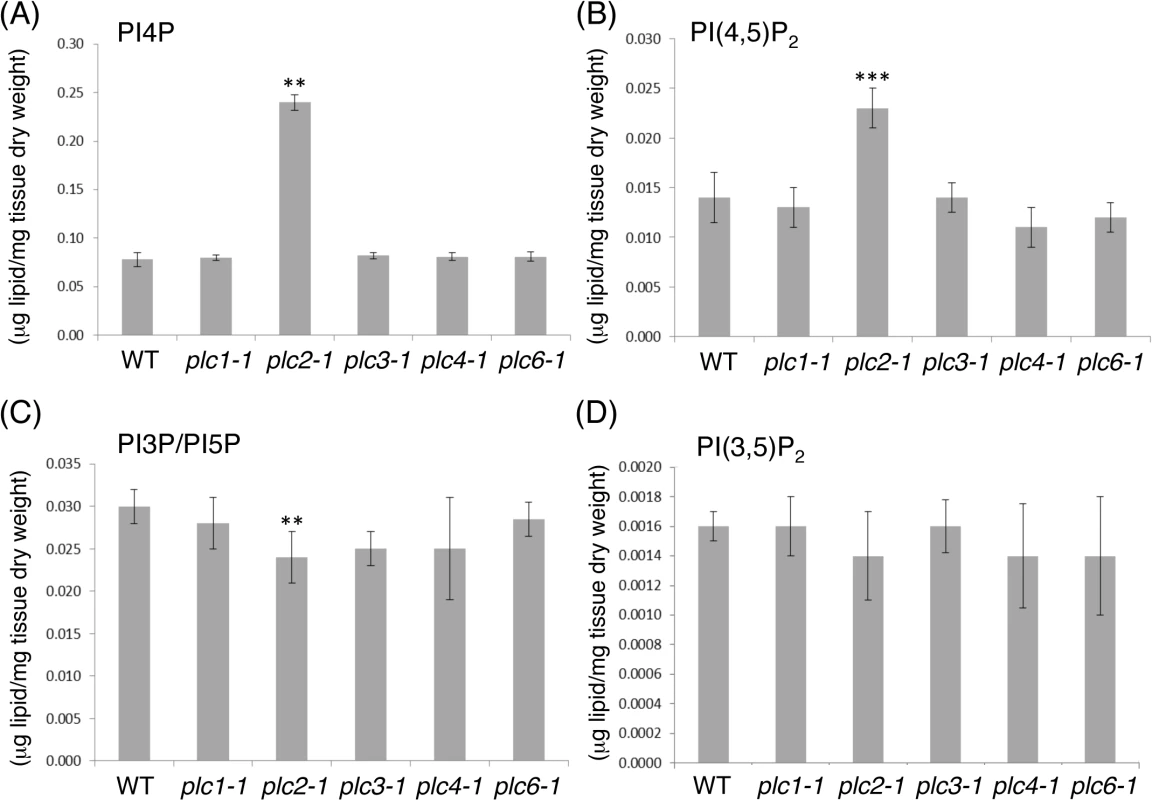
Tissue localization of AtPLC2
AtPLC2 transcript is ubiquitously detected in most of plant tissues as shown in Fig 2B [7,12]; however, little is known about the protein localization of AtPLC2. To explore the tissue localization of AtPLC2 protein, we created a transgenic plant that expresses AtPLC2 fused to a GUS gene driven by the AtPLC2 promoter (ProPLC2:PLC2-GUS). GUS staining was observed in trichomes, particularly at the base, in developing true leaves of ProPLC2:PLC2-GUS transgenic plants (Fig 4A). As the leaves developed, staining was found in leaf vasculature but not at the trichome (Fig 4B). In the inflorescences, staining was found in young buds; entire buds were stained in the early stages (Fig 4C), while carpels and vasculature of petals were stained after the onset of reproductive organ development (Fig 4D). In mature flowers, staining was restricted to the stigma, filament and the boundary region between the filament and stamen (Fig 4E). In roots, GUS staining was found in vasculature (Fig 4F). In addition, intense staining was observed at the branch of lateral roots and root tips. A closer look at the tip of a primary root showed differential patterns of GUS staining: intense and uniform distribution at cell division and elongation zones but restricted staining at vasculature in maturation zones (Fig 4G).
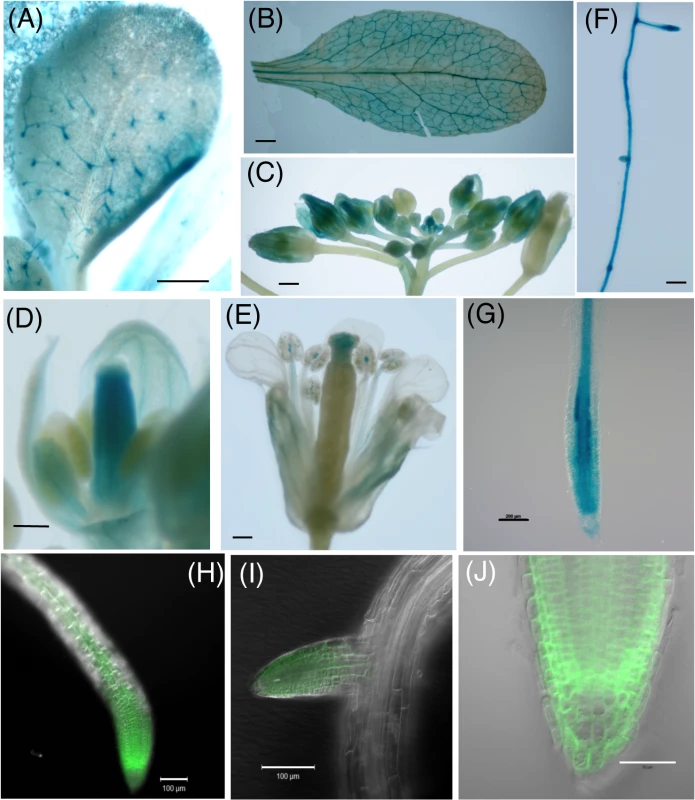
Subcellular localization of AtPLC2 protein
Next, to observe the subcellular localization of AtPLC2 protein, we created a transgenic line that expresses AtPLC2 fused to the fluorescent protein Venus (ProPLC2:PLC2-Venus). In agreement with GUS staining, strong signals appeared at the tip of main roots (Fig 4H) and branching lateral root (Fig 4I). At the root tips, fluorescent signals were more evenly distributed across different cell types except columellae (Fig 4J). This localization is in agreement with previous biochemical study of anti-PLC2 antibody detecting enrichment of the antigen in the plasma-membrane-enriched fraction [28].
To further study the subcellular localization of AtPLC2 in different tissues, we observed stem epidermal cells (Fig 5A–5D), leaf epidermal cells (Fig 5E–5H), and mesophyll cells (Fig 5I–5L). In all cells observed here, the Venus signals were co-localized with the plasma membrane marker FM4-64 but not with the nuclear marker 4’,6’-diamino-2’-phenylindole (DAPI) or autofluorescence of chloroplasts (Fig 5M–5P). In addition to supporting the previous study [28], these observations suggest that AtPLC2 localizes mainly at the plasma membrane in different cell types.
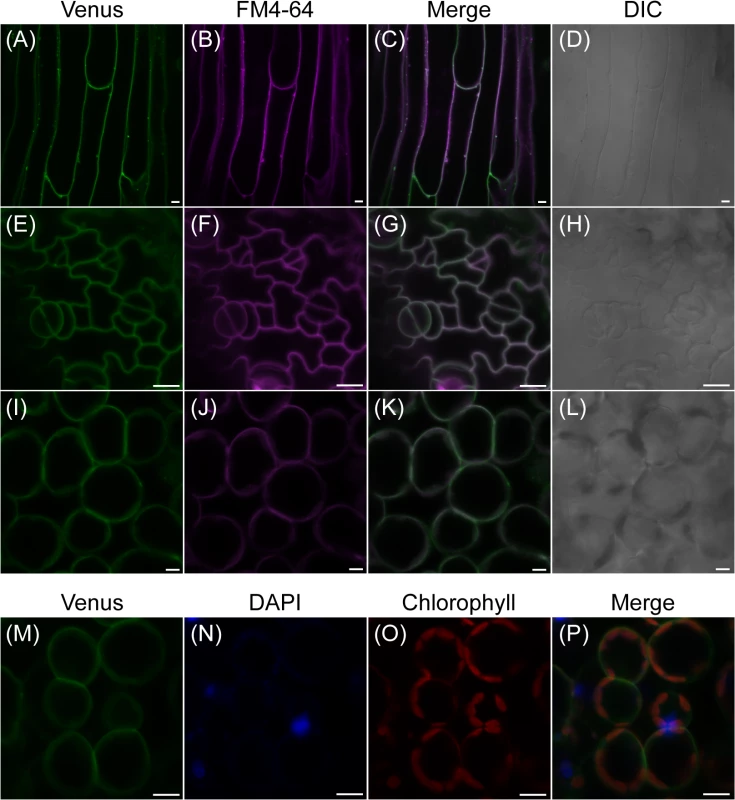
Seedling growth retardation of the plc2-1 mutant
The seedlings of plc2-1 cultured on solid Murashige and Skoog (MS) media showed growth retardation both in shoots and roots (Fig 6A). The overall root length of 15-day-old seedlings was significantly reduced as compared with that of the wild-type plants in Wassilewskija (Ws) ecotype (Fig 6B). The fresh weight and dry weight were also reduced by nearly 70% and 80%, respectively, compared with that of the wild-type plants (Fig 6C and 6D). These growth retardations of the plc2-1 mutant were fully complemented in two independent lines harboring a genomic sequence of AtPLC2 (ProPLC2:PLC2) in the plc2-1 mutant (plc2-1 ProPLC2:PLC2 #1 and #3) in root length, fresh weight and dry weight (Fig 6A–6D). To exclude a possibility that this growth defect is ecotype-specific, the plc2-1 mutant was introgressed into Columbia-0 (Col) ecotype by backcrossing six times. In consistent with that in the Ws background, the plc2-1 (Col) mutant showed growth retardation both in shoots and roots (Fig 6E and 6F). Moreover, this growth defect was also fully complemented by heterologous expression of AtPLC2 in the plc2-1 (Col) [plc2-1 (Col) ProPLC2:PLC2] as shown in Fig 7A–7C. These observations indicate that the growth defect in the plc2-1 mutant is due to knocking out of AtPLC2.
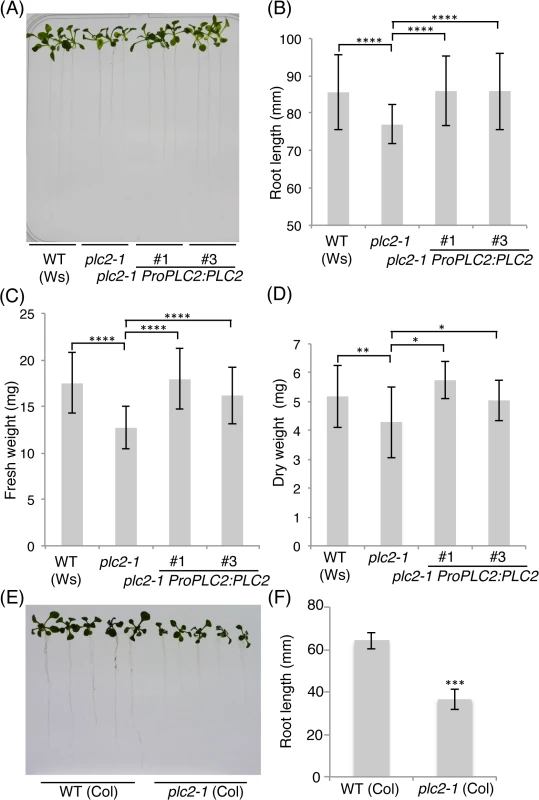
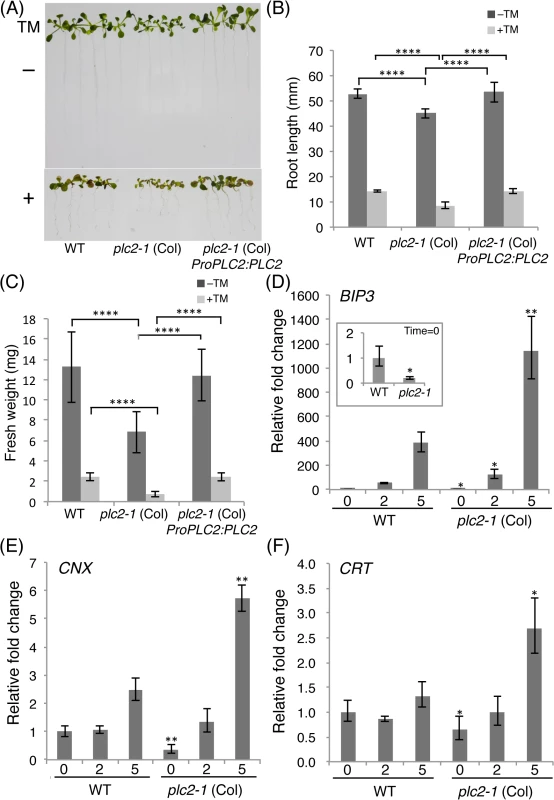
Enhanced susceptibility of the plc2-1 roots to ER stress
To investigate whether phosphoinositides are involved in ER stress tolerance, we examined sensitivity of the plc2-1 mutant against the tunicamycin (TM)–induced ER stress. TM inhibits the protein N-glycosylation pathway in the ER and thus induces the ER stress. Treatment of TM produced growth defects in the wild-type seedlings: smaller rosette leaves and shorter roots (Fig 7A). These phenotypes were even stronger in the plc2-1 mutant (Fig 7A). In response to the ER stress, root length of the plc2-1 mutant was shortened to 19.1% that of control treatment, whereas that of the wild type was shortened by 27.3% (Fig 7B). Consistent with this, the fresh weight of whole seedlings of the plc2-1 mutant was reduced to 10.8% that of control treatment, whereas that of the wild type was reduced to 18.4% in response to the ER stress. These defects in the plc2-1 mutant were complemented in the plc2-1 (Col) ProPLC2:PLC2 transgenic plant: reductions of root length and fresh weight upon the ER stress were 26.7% and 19.9%, respectively (Fig 7B and 7C). To determine whether this enhanced growth defect was due to a compromised ER stress response, we examined the expression of ER stress responsive genes [29]: binding protein 3 (BiP3), calnexin (CNX) and calreticulin (CRT) [30,31]. Expression of all of these genes was significantly higher in the plc2-1 mutant than in the wild type (Fig 7D–7F) in response to the ER stress. In addition, gene expression levels at 0 h were lower in the plc2-1 mutant than in the wild type (Fig 7D–7F). These data suggest that the plc2-1 mutant is hypersensitive to the ER stress. Thus, AtPLC2 function contributes to the ER stress response.
Discussion
The Arabidopsis AtPLC2 was first cloned by Hirayama et al. (1997) after the first cloning and functional analysis of AtPLC1 [8]. AtPLC2 shows PI(4,5)P2-specific PLC activity in vitro and requires 1–100 μM Ca2+ for its activity [28]. However, because of lack of AtPLC2 mutant analyses, the in vivo role of AtPLC2 in the entire phosphoinositide metabolism was unclear. Given that at least nine AtPLCs have been reported in Arabidopsis [5,6], whether any of these have a decisive role in phosphoinositide metabolism or whether most have redundant roles in the process is a major issue to be addressed [1]. Here, we isolated AtPLC mutants and profiled their phosphoinositide levels (Fig 3). Knockout of AtPLC2 significantly increased levels of PI(4,5)P2, a primary substrate of PI-PLC, suggesting that AtPLC2 may be a major PI-PLC involved in phosphoinositide metabolism.
We found no significant changes in phosphoinositide levels in the plc1-1, plc3-1, plc4-1, and plc6-1 mutants, even though corresponding genes AtPLC1, AtPLC3, AtPLC4, and AtPLC6 encode functional proteins [8,9,32]. These PI-PLC genes are transcriptionally induced by various stresses such as salt, cold and dehydration, whereas AtPLC2 expression is stable but higher than that of the others (Fig 2A) [7,12]. These AtPLCs may be conditional isoforms contributing to specific conditions with specific localization, whereas AtPLC2 expresses continuously and serves for the basal metabolism of phosphoinositides, thus affecting their levels when knocked out. It would be of interest to determine whether different PLCs affect phosphoinositide levels differently in specific tissues or under different stress conditions in future studies.
Our reporter assay by GUS and Venus revealed that AtPLC2 is primarily expressed in vascular tissues in leaves (Fig 4B), petals (Fig 4D), filaments (Fig 4E), and roots (Fig 4F and 4G). Moreover, AtPLC2 expression was observed in tissues with active cell proliferation, such as trichomes (Fig 4A), young floral buds (Fig 4C), and root founder cells (Fig 4F). Previously, GUS reporter assay was conducted for AtPLC1, AtPLC4 and AtPLC5 [6], which showed that both AtPLC1 and AtPLC5 were expressed in vascular tissues of roots and leaves but AtPLC4 was expressed exclusively in pollen and in cells of the stigma surface. Besides, AtPLC5 was also expressed in guard cells and various floral organs. Based on our observation, while expression of AtPLC2 in vascular tissues was similar to that of AtPLC1 and AtPLC5, expression of AtPLC2 in tissues with active cell proliferation was not observed in the previously studied PLC isoforms and thus was a distinct feature. This tissue specificity corresponds with the suggested roles of phosphoinositides. The contribution of phosphoinositides in vascular tissues is suggested by analysis of mutants affecting phosphoinositide phosphatases. FRAGILE FIBER 3 encodes inositol polyphosphate 5-phosphatase and is required for secondary wall synthesis and actin organization in fiber cells [33]. A specific PI(3,5)P2 phosphatase encoded by SAC1 is involved in cell morphogenesis, cell wall synthesis and actin organization [34]. VAN3, which is essential in leaf vascular development, has a pleckstrin homology domain that binds PI4P [35]. Indeed, CVP2, an inositol 5-phosphatase whose knockout confers a phenotype similar to that of van3, acts partially with VAN3 to regulate the continuity of vasculature [36,37]. In line with this evidence which suggests an involvement of multiple phosphoinositide phosphatases in vascular development, altered levels of PI(4,5)P2 or IP3 by AtPLC2 may influence the substrate availability of these phosphatases, thus affecting seedling growth.
The seedlings of plc2-1 were smaller than those of the wild type in both Ws and Col ecotypes (Figs 6 and 7). The growth defect was complemented by transforming ProPLC2:PLC2, which indicates that AtPLC2 is the primary isoform that contributes to seedling growth. Reduced primary root length of the plc2-1 mutant suggests reduced competence of the root apical meristem. PI4K is important in trafficking from the trans-Golgi network to the prevacuolar compartment [38]. AtPLC2 may cooperate with PI4K for a straightforward signaling pathway for efficient generation of IP3 and DAG.
The plc2-1 mutant showed hypersensitivity against the TM-induced ER stress. Although there is still limited information about the connection between phosphoinositides and ER homeostasis, membrane stress caused by imbalanced lipid composition triggers the UPR to reprogram protein homeostasis in yeast [39]. In addition, inhibition of PC biosynthesis in mammalian cells induces ER stress presumably by significant alteration of membrane lipid composition [40]. Furthermore, phosphoinositides are involved in vesicular membrane trafficking [38]. In Arabidopsis, microarray analysis showed ER stress-induced expression of gene encoding PI4Kγ2, which may catalyze a reaction to produce PI4P and provide a substrate for AtPLCs (Fig 1A) [23]. Altered phosphoinositide composition will affect membrane integrity or vesicle trafficking, causing a hypersensitive response to the ER stress.
In animal and microbial research fields, function of PLCs has been studied extensively. However, involvement of PLCs in ER stress is not well-known. For example, ER stress decreases the expression of PLC-β1 isoform in neurons [41]. Regarding the connection between phosphoinositides and ER homeostasis, involvement of phosphatidylinositol 3-kinase (PI3K) in ER stress response has been suggested. For example, suppression of p85α, a regulatory subunit of class Ia PI3K reduces ER stress-dependent accumulation of nuclear X-box-binding protein-1 (XBP-1), a transcriptional regulator of the UPR [42,43]. This decreases induction of UPR target genes and stimulates apoptosis [43]. Moreover, involvement of phosphatidylinositol synthesis in ER stress is reported in Zebrafish [44,45]. These studies highlight an importance of entire phosphoinositide signaling in ER stress response. Our finding that knocking out of AtPLC2 altered phosphoinositide profiles and caused hypersensitivity to ER stress in Arabidopsis not only supports the importance of phosphoinositides but highlights a crucial role of PLC function in ER stress, which is not described clearly in the animal research field. Plants may possess a distinct regulatory mechanism to transduce phosphoinositide signals under the ER stress.
In consistent with the previous study [28], AtPLC2 mainly localized at the plasma membrane (Fig 5). It is intriguing that plasma membrane-localized AtPLC2 is involved in the ER stress response. Recently, Yang et al. (2014) reported that a plasma membrane-associated transcription factor, NAC062, mediates the UPR in Arabidopsis [46]. NAC062 relocates from the plasma membrane to the nucleus upon the ER stress, and then regulates gene expression downstream of UPR. NAC062 is one of the plant-specific NAC (NAM, ATAF1,2, CUC2) transcription factors, and its expression is up-regulated by the ER stress. However, how the plasma membrane-associated NAC062 responds to the ER stress is poorly understood. Interestingly, a highly dynamic organelle was observed that is derived from the ER and serves as a major source of phosphatidylinositol to supply phosphoinositides to cellular membranes [47]. It is possible that plasma membrane-localized AtPLC2 might also take ER-derived phosphoinositides as a substrate and play a role in the ER stress response. Furthermore, a direct physical connection has been observed between the plasma membrane and the ER [48]. It is possible that AtPLC2-generated signals may be transduced to the ER through the direct contact site. Higher plants may have evolved a unique mechanism involving cross-talk between the ER and plasma membrane to cope with the ER stress.
In conclusion, AtPLC2 is the major PI-PLC involved in phosphoinositide metabolism and seedling growth in Arabidopsis. Moreover, it is important for the ER stress tolerance, which suggests the link between phosphoinositide signaling and the ER stress response. We suggest AtPLC2 as a key enzyme in the phosphoinositide metabolic system and a novel concept in ER homeostasis associated with phosphoinositides evidenced by the functional study of the plc2-1 mutant.
Methods
Plant materials and growth condition
Arabidopsis plants (Columbia-0 ecotype, unless specified) were grown under 16-h light/8-h dark condition at 22°C. Murashige and Skoog (MS) media were used at ½ concentration for plant culture [49]. Mutant seeds were obtained from The Arabidopsis Information Resource (TAIR), except for plc2-1 seeds, which were obtained from the Institut National de la Recherche Agronomique (INRA): plc1-1 (SALK_025769), plc2-1 (FLAG_506C04), plc3-1 (CS879873), plc4-1 (CS876876), plc6-1 (SALK_041365). The plc2-1 mutant was in Wassilewskija (Ws) ecotype, and was therefore backcrossed with Col-0 ecotype six times to replace the ecotypical background. The obtained mutant was named plc2-1 (Col).
Plasmid vector construction and plant transformation
For genomic complementation of the plc2-1 mutant, about 4 kb of the genomic sequence for AtPLC2 was amplified by PCR with oligonucleotide primers KY101 and KY102 and cloned into the pENTR/D-TOPO plasmid vector (Invitrogen, Carlsbad, CA) to obtain pYN2030. Positive clones were sequenced to confirm accuracy and were recombined to the pHGW destination vector by use of LR clonase (Invitrogen, Carlsbad, CA) [50]. The obtained plasmid, pYN3051, was transformed into Agrobacterium GV3101 for transformation into the plc2-1 and plc2-1 (Col) mutants.
The GUS reporter construct was created as follows: the SfoI site was introduced immediately before the stop codon of pYN2030 by site-directed mutagenesis [51] with the oligonucleotide primer KY103 to obtain pYN2031. Next, a GUS fragment was inserted into the SfoI site to produce pYN2036. This entry vector was recombined to the pHGW destination vector by use of LR clonase. The resulting plasmid pYN3045 was transformed into Agrobacterium GV3101 for transformation into the plc2-1 mutant.
The Venus fluorescent reporter construct was created by inserting a triple Venus fragment into pYN2031. The obtained entry vector pYN2037 was recombined to the pHGW destination vector by use of LR clonase and the resulting plasmid pYN3037 was transformed into Agrobacterium GV3101 for transformation into the plc2-1 mutant. All transformed plants were screened on MS media containing hygromycin.
Lipid extraction and profiling
Lipid extraction was conducted under the acidic condition for efficient recovery of phosphoinositides as described [52]. Briefly, samples were ground in 10 volumes of extraction solvent (ice-cold chloroform:methanol:concentrated HCl = 100:100:0.7) and centrifuged, then supernatant was separated. The remaining pellet was re-extracted with 4 volumes of extraction solvent and centrifuged to recover the supernatant. Two supernatant fractions were combined with 2 volumes of 0.6 N HCl, mixed, centrifuged, and the upper phase was removed. The lower phase was washed 3 times with 4 volumes of washing solvent (chloroform:methanol:0.6 N HCl = 3:48:47), dried and dissolved in chloroform:methanol = 2:1 for storage at -80°C.
Analysis of PI4P, PI3P/PI5P, PI(4,5)P2, and PI(3,5)P2 levels was quantified as described [53] by use of Dionex Ion Chromatography 3000 (Dionex, Sunnyvale, CA, USA). Lipid extracts were deacylated by incubation with 0.5 ml methylamine reagent [MeOH/40% methylamine in water/1-butanol/water (47:36:9:8)] at 50°C for 45 min. The aqueous phase was dried, resuspended in 0.5 ml of 1-butanol/petroleum ether/ethyl formate (20:40:1) and extracted twice with an equal volume of water. Aqueous extracts were dried, resuspended in water, and subjected to anion-exchange high-performance liquid chromatography on an Ionpac AS11-HC column (Dionex, Sunnyvale, CA, USA). Negatively charged glycerol head groups were eluted with a 1.5–86 mM KOH gradient and detected online by suppressed conductivity 75 in a Dionex ion chromatography system equipped with an ASRS-ultra II self-regenerating suppressor. Individual peaks were identified, and peak areas were calculated by use of Chromeleon (Dionex, Sunnyvale, CA, USA). Lipid levels were calculated with deacylated anionic phospholipids using as standards.
GUS staining
Harvested fresh tissues other than roots were immediately immersed in ice-cold 90% (v/v) acetone for 15 min, then with GUS staining solution [10 mM EDTA, 5 mM potassium ferricyanide, 5 mM potassium ferrocyanide, 0.1% (w/v) Triton X-100, 0.5 mg/ml X-Gluc (5-bromo-4-chloro-3-indolyl-β-D-glucuronide) in 100 mM phosphate buffer]. After incubation in the dark at 37°C for 30 min, staining was stopped by replacing the solution with 70% ethanol. For colored tissues, pigments were removed by immersing the tissue in ethanol:acetic acid = 6:1 (in vol).
Tunicamycin treatment
For phenotypical observations, the plants were grown on MS media for 7 days, and then transferred to MS media containing 0.3 μg/ml tunicamycin for an additional 6 days of culture. For the quantitative RT-PCR (qRT-PCR) analysis, the plants were grown on MS media for 7 days. Then, the seedlings were transferred to MS media containing 5 μg/ml tunicamycin, and were harvested at the times indicated as described [23]. Dimethyl sulfoxide (DMSO) was used as a control for both experiments.
Confocal laser-scanning microscopy
Venus expression in the ProPLC2:PLC2-Venus transgenic line in 12-day-old seedlings was observed under a microscope (LSM 510 Meta; Carl Zeiss, Jena, Germany) equipped with LCI Plan-Neofluar 63x/1.3 NA immersion, Plan-Apochromat 20x/0.8 NA, and Plan-Apochromat 10x/0.45 NA. For plasma membrane staining, seedlings were immersed in 10 μg/ml of FM 4–64 (Invitrogen, Carlsbad, CA, USA) for 10 min and subjected to confocal microscopy observation. For nucleus staining, samples were immersed in 10 μg/ml of DAPI (Invitrogen, Carlsbad, CA, USA) for 10 min and subjected to confocal microscopy observation. Images were captured by use of LSM 510 v3.2 (Carl Zeiss, Jena, Germany) with filters for Venus (514 nm laser, BP 520–555), FM 4–64 (543 nm laser, BP 560–615), DAPI (405 nm laser, BP 420–480), and chlorophyII autofluorescence (488 nm laser, LP 650).
RT-PCR analysis
Total RNA was isolated from 2-week-old seedlings except AtPLC6 using plant RNeasy mini kit (Qiagen, Dusseldorf, Germany) according to the manufacture’s instruction. RNase-free DNase (Qiagen, Dusseldorf, Germany) was used during the on-column digestion to remove genomic DNA contamination. For AtPLC6, total RNA isolated from the flowers of 5-week-old plants were used because AtPLC6 highly expresses during flower development [54]. The cDNA was synthesized by the SuperScriptIII First-Strand Synthesis System (Invitrogen, Carlsbad, CA, USA) and used as the templates for RT-PCR analysis. Actin (ACT) was used as a control. The primers used are listed in S1 Table.
Quantitative RT-PCR (qRT-PCR)
Total RNA was isolated from 7-day-old seedlings using TRI reagent (Ambion, Austin, TX, USA) including DNase treatment according to the manufacture’s instruction, and cDNA was synthesized by the SuperScriptIII First-Strand Synthesis System (Invitrogen, Carlsbad, CA, USA). qRT-PCR was performed with the 7500 Real Time PCR System (Applied Biosystems, Foster city, CA, USA). The comparative threshold cycle (CT) method was used to determine the relative amount of gene expression, with the expression of ACT used as an internal control [29]. The means and standard deviations were calculated from three technical replicates. Three biologically independent experiments were performed with similar results. The primer sets for qRT-PCR are listed in S1 Table.
Supporting Information
Zdroje
1. Boss WF, Im YJ. Phosphoinositide signaling. Annu Rev Plant Biol. 2012;63: 409–429. doi: 10.1146/annurev-arplant-042110-103840 22404474
2. Arisz SA, Testerink C, Munnik T. Plant PA signaling via diacylglycerol kinase. Biochim Biophys Acta. 2009;1791: 869–875. doi: 10.1016/j.bbalip.2009.04.006 19394438
3. Nakamura Y, Awai K, Masuda T, Yoshioka Y, Takamiya K, Ohta H. A novel phosphatidylcholine-hydrolyzing phospholipase C induced by phosphate starvation in Arabidopsis. J Biol Chem. 2005;280: 7469–7476. doi: 10.1074/jbc 15618226
4. Gaude N, Nakamura Y, Scheible WR, Ohta H, Dörmann P. Phospholipase C5 (NPC5) is involved in galactolipid accumulation during phosphate limitation in leaves of Arabidopsis. Plant J. 2008;56: 28–39. doi: 10.1111/j.1365-313X.2008.03582.x 18564386
5. Mueller-Roeber B, Pical C. Inositol phospholipid metabolism in Arabidopsis. Characterized and putative isoforms of inositol phospholipid kinase and phosphoinositide-specific phospholipase C. Plant Physiol. 2002;130: 22–46. doi: 10.1104/Pp.004770 12226484
6. Hunt L, Otterhag L, Lee JC, Lasheen T, Hunt J, Seki M, et al. Gene-specific expression and calcium activation of Arabidopsis thaliana phospholipase C isoforms. New Phytol. 2004;162: 643–654. doi: 10.1111/J.1469-8137.2004.01069.X
7. Tasma IM, Brendel V, Whitham SA, Bhattacharyya MK. Expression and evolution of the phosphoinositide-specific phospholipase C gene family in Arabidopsis thaliana. Plant Physiol Biochem. 2008;46: 627–637. doi: 10.1016/j.plaphy.2008.04.015 18534862
8. Hirayama T, Ohto C, Mizoguchi T, Shinozaki K. A gene encoding a phosphatidylinositol-specific phospholipase C is induced by dehydration and salt stress in Arabidopsis thaliana. Proc Natl Acad Sci USA. 1995;92: 3903–3907. doi: 10.1073/pnas.92.9.3903 7732004
9. Sanchez JP, Chua NH. Arabidopsis PLC1 is required for secondary responses to abscisic acid signals. Plant Cell. 2001;13: 1143–1154. doi: 10.1105/tpc.13.5.1143 11340187
10. Zheng SZ, Liu YL, Li B, Shang ZL, Zhou RG, Sun DY. Phosphoinositide-specific phospholipase C9 is involved in the thermotolerance of Arabidopsis. Plant J. 2012;69: 689–700. doi: 10.1111/j.1365-313X.2011.04823.x 22007900
11. Gao K, Liu YL, Li B, Zhou RG, Sun DY, Zheng SZ. Arabidopsis thaliana phosphoinositide-specific phospholipase C isoform 3 (AtPLC3) and AtPLC9 have an additive effect on thermotolerance. Plant Cell Physiol. 2014;55: 1873–1883. doi: 10.1093/pcp/pcu116 25149227
12. Hirayama T, Mitsukawa N, Shibata D, Shinozaki K. AtPLC2, a gene encoding phosphoinositide-specific phospholipase C, is constitutively expressed in vegetative and floral tissues in Arabidopsis thaliana. Plant Mol Biol. 1997;34: 175–180. doi: 10.1023/A:1005885230896 9177324
13. Liu JX, Srivastava R, Che P, Howell SH. Salt stress responses in Arabidopsis utilize a signal transduction pathway related to endoplasmic reticulum stress signaling. Plant J. 2007;51: 897–909. doi: 10.1111/j.1365-313X.2007.03195.x 17662035
14. Deng Y, Humbert S, Liu JX, Srivastava R, Rothstein SJ, Howell SH. Heat induces the splicing by IRE1 of a mRNA encoding a transcription factor involved in the unfolded protein response in Arabidopsis. Proc Natl Acad Sci USA. 2011;108: 7247–7252. doi: 10.1073/pnas.1102117108 21482766
15. Cox JS, Walter P. A novel mechanism for regulating activity of a transcription factor that controls the unfolded protein response. Cell. 1996;87: 391–404. doi: 10.1016/S0092-8674(00)81360-4 8898193
16. Mori K, Ma WZ, Gething MJ, Sambrook J. A transmembrane protein with a Cdc2+/Cdc28-related kinase-activity is required for signaling from the ER to the nucleus. Cell. 1993;74: 743–756. doi: 10.1016/0092-8674(93)90521-Q 8358794
17. Ron D, Walter P. Signal integration in the endoplasmic reticulum unfolded protein response. Nat Rev Mol Cell Biol. 2007;8: 519–529. doi: 10.1038/nrm2199 17565364
18. Brodsky JL, McCracken AA. ER-associated and proteasome-mediated protein degradation: How two topologically restricted events came together. Trends Cell Biol. 1997;7: 151–156. doi: 10.1016/S0962-8924(97)01020-9 17708933
19. Tsai B, Ye Y, Rapoport TA. Retro-translocation of proteins from the endoplasmic reticulum into the cytosol. Nat Rev Mol Cell Biol. 2002;3: 246–255. doi: 10.1038/nrm780 11994744
20. Kanehara K, Kawaguchi S, Ng DT. The EDEM and Yos9p families of lectin-like ERAD factors. Semin Cell Dev Biol. 2007;18: 743–50. doi: 10.1016/j.semcdb.2007.09.007 17945519
21. Harding HP, Zhang Y, Bertolotti A, Zeng H, Ron D. Perk is essential for translational regulation and cell survival during the unfolded protein response. Mol Cell. 2000;5: 897–904. doi: 10.1016/S1097-2765(00)80330-5 10882126
22. Brodsky JL, Skach WR. Protein folding and quality control in the endoplasmic reticulum: Recent lessons from yeast and mammalian cell systems. Curr Opin Cell Biol. 2011;23: 464–475. doi: 10.1016/j.ceb.2011.05.004 21664808
23. Iwata Y, Fedoroff NV, Koizumi N. Arabidopsis bZIP60 is a proteolysis-activated transcription factor involved in the endoplasmic reticulum stress response. Plant Cell. 2008;20: 3107–3121. doi: 10.1105/tpc.108.061002 19017746
24. Su W, Liu Y, Xia Y, Hong Z, Li J. Conserved endoplasmic reticulum-associated degradation system to eliminate mutated receptor-like kinases in Arabidopsis. Proc Natl Acad Sci U S A. 2010;108: 870–875. doi: 10.1073/pnas.1013251108 21187394
25. Liu JX, Howell SH. Endoplasmic reticulum protein quality control and its relationship to environmental stress responses in plants. Plant Cell. 2010;22: 2930–2942. doi: 10.1105/tpc.110.078154 20876830
26. Howell SH. Endoplasmic reticulum stress responses in plants. Annu Rev Plant Biol. 2013;64: 477–499. doi: 10.1146/annurev-arplant-050312-120053 23330794
27. Fagone P, Jackowski S. Membrane phospholipid synthesis and endoplasmic reticulum function. J Lipid Res. 2009;50 Suppl:S311–316. doi: 10.1194/jlr.R800049-JLR200 18952570
28. Otterhag L, Sommarin M, Pical C. N-terminal EF-hand-like domain is required for phosphoinositide-specific phospholipase C activity in Arabidopsis thaliana. FEBS Lett. 2001;497: 165–170. doi: 10.1016/S0014-5793(01)02453-X 11377433
29. Liu JX, Srivastava R, Che P, Howell SH. An endoplasmic reticulum stress response in Arabidopsis is mediated by proteolytic processing and nuclear relocation of a membrane-associated transcription factor, bZIP28. Plant Cell. 2007;19: 4111–4119. doi: 10.1105/tpc.106.050021 18156219
30. Martinez IM, Chrispeels MJ. Genomic analysis of the unfolded protein response in Arabidopsis shows its connection to important cellular processes. Plant Cell. 2003;15: 561–576. doi: 10.1105/tpc.007609 12566592
31. Noh SJ, Kwon CS, Oh DH, Moon JS, Chung WI. Expression of an evolutionarily distinct novel BiP gene during the unfolded protein response in Arabidopsis thaliana. Gene. 2003;311: 81–91. doi: 10.1016/S0378-1119(03)00559-6 12853141
32. Cao Z, Zhang J, Li Y, Xu X, Liu G, Bhattacharrya MK, et al. Preparation of polyclonal antibody specific for AtPLC4, an Arabidopsis phosphatidylinositol-specific phospholipase C in rabbits. Protein Expr Purif. 2007;52: 306–312. doi: 10.1016/j.pep.2006.10.007 17142056
33. Zhong R, Burk DH, Morrison WH, Ye ZH. FRAGILE FIBER3, an Arabidopsis gene encoding a type II inositol polyphosphate 5-phosphatase, is required for secondary wall synthesis and actin organization in fiber cells. Plant Cell. 2004;16: 3242–3259. doi: 10.1105/tpc.104.027466 15539468
34. Zhong R, Burk DH, Nairn CJ, Wood-Jones A, Morrison WH III, Ye ZH. Mutation of SAC1, an Arabidopsis SAC domain phosphoinositide phosphatase, causes alterations in cell morphogenesis, cell wall synthesis, and actin organization. Plant Cell. 2005;17: 1449–1466. doi: 10.1105/tpc.105.031377 15805481
35. Koizumi K, Naramoto S, Sawa S, Yahara N, Ueda T, Nakano A, et al. VAN3 ARF-GAP-mediated vesicle transport is involved in leaf vascular network formation. Development. 2005;132: 1699–1711. doi: 10.1242/dev.01716 15743878
36. Carland FM, Nelson T. COTYLEDON VASCULAR PATTERN2-mediated inositol (1,4,5) triphosphate signal transduction is essential for closed venation patterns of Arabidopsis foliar organs. Plant Cell. 2004;16: 1263–1275. doi: 10.1105/tpc.021030 15100402
37. Naramoto S, Sawa S, Koizumi K, Uemura T, Ueda T, Friml J, et al. Phosphoinositide-dependent regulation of VAN3 ARF-GAP localization and activity essential for vascular tissue continuity in plants. Development. 2009;136: 1529–1538. doi: 10.1242/dev.030098 19363154
38. Kim DH, Eu YJ, Yoo CM, Kim YW, Pih KT, Jin JB, et al. Trafficking of phosphatidylinositol 3-phosphate from the trans-Golgi network to the lumen of the central vacuole in plant cells. Plant Cell. 2001;13: 287–301. doi: 10.1105/tpc.13.2.287 11226186
39. Thibault G, Shui G, Kim W, McAlister GC, Ismail N, Gygi SP, et al. The membrane stress response buffers lethal effects of lipid disequilibrium by reprogramming the protein homeostasis network. Mol Cell. 2012;48: 16–27. doi: 10.1016/j.molcel.2012.08.016 23000174
40. van der Sanden MH, Houweling M, van Golde LM, Vaandrager AB. Inhibition of phosphatidylcholine synthesis induces expression of the endoplasmic reticulum stress and apoptosis-related protein CCAAT/enhancer-binding protein-homologous protein (CHOP/GADD153). Biochem J. 2003;369: 643–650. doi: 10.1042/BJ20020285 12370080
41. Yasuda E, Nagasawa K, Nishida K, Fujimoto S. Decreased expression of phospholipase C-beta 1 protein in endoplasmic reticulum stress-loaded neurons. Biol Pharm Bull. 2008;31: 719–721. doi: 10.1248/bpb.31.719 18379069
42. Sriburi R, Jackowski S, Mori K, Brewer JW. XBP1: a link between the unfolded protein response, lipid biosynthesis, and biogenesis of the endoplasmic reticulum. J Cell Biol. 2004;167: 35–41. doi: 10.1083/Jcb.200406136 15466483
43. Winnay JN, Boucher J, Mori MA, Ueki K, Kahn CR. A regulatory subunit of phosphoinositide 3-kinase increases the nuclear accumulation of X-box-binding protein-1 to modulate the unfolded protein response. Nat Med. 2010;16: 438–445. doi: 10.1038/nm.2121 20348923
44. Thakur PC, Stuckenholz C, Rivera MR, Davison JM, Yao JK, Amsterdam A, et al. Lack of de novo phosphatidylinositol synthesis leads to endoplasmic reticulum stress and hepatic steatosis in cdipt-deficient zebrafish. Hepatology. 2011;54: 452–462. doi: 10.1002/hep.24349 21488074
45. Thakur PC, Davison JM, Stuckenholz C, Lu L, Bahary N. Dysregulated phosphatidylinositol signaling promotes endoplasmic-reticulum-stress-mediated intestinal mucosal injury and inflammation in zebrafish. Dis Model Mech. 2014;7: 93–106. doi: 10.1242/dmm.012864 24135483
46. Yang ZT, Lu SJ, Wang MJ, Bi DL, Sun L, Zhou SF, et al. A plasma membrane-tethered transcription factor, NAC062/ANAC062/NTL6, mediates the unfolded protein response in Arabidopsis. Plant J. 2014;79: 1033–1043. doi: 10.1111/Tpj.12604 24961665
47. Kim YJ, Guzman-Hernandez ML, Balla T. A highly dynamic ER-derived phosphatidylinositol-synthesizing organelle supplies phosphoinositides to cellular membranes. Dev Cell. 2011;21: 813–824. doi: 10.1016/j.devce1.2011.09.005 22075145
48. Wang PW, Hawkins TJ, Richardson C, Cummins I, Deeks MJ, Sparkes I, et al. The plant cytoskeleton, NET3C, and VAP27 mediate the link between the plasma membrane and endoplasmic reticulum. Curr Biol. 2014;24: 1397–1405. doi: 10.1016/J.Cub.2014.05.003 24909329
49. Murashige T, Skoog F. A revised medium for rapid growth and bio assays with tobacco tissue cultures. Physiol Plantarum. 1962;15: 473–497. doi: 10.1111/J.1399-3054.1962.Tb08052.X
50. Karimi M, De Meyer B, Hilson P. Modular cloning in plant cells. Trends Plant Sci. 2005;10: 103–105. doi: 10.1016/j.tplants.2005.01.008 15749466
51. Sawano A, Miyawaki A. Directed evolution of green fluorescent protein by a new versatile PCR strategy for site-directed and semi-random mutagenesis. Nucleic Acids Res. 2000;28: E78. doi: 10.1093/nar/28.16.e78 10931937
52. Drobak BK, Brewin NJ, Hernandez LE. Extraction, separation, and analysis of plant phosphoinositides and complex glycolipids. Methods Mol Biol. 2000;141: 157–174. doi: 10.1385/1-59259-067-5:157 10820743
53. Nasuhoglu C, Feng S, Mao J, Yamamoto M, Yin HL, Earnest S, et al. Nonradioactive analysis of phosphatidylinositides and other anionic phospholipids by anion-exchange high-performance liquid chromatography with suppressed conductivity detection. Anal Biochem. 2002;301: 243–254. doi: 10.1006/abio.2001.5489 11814295
54. Nakamura Y, Teo NZW, Shui GH, Chua CHL, Cheong WF, Parameswaran S, et al. Transcriptomic and lipidomic profiles of glycerolipids during Arabidopsis flower development. New Phytol. 2014;203: 310–322. doi: 10.1111/Nph.12774 24684726
Štítky
Genetika Reprodukčná medicínaČlánok vyšiel v časopise
PLOS Genetics
2015 Číslo 9
- Je „freeze-all“ pro všechny? Odborníci na fertilitu diskutovali na virtuálním summitu
- Gynekologové a odborníci na reprodukční medicínu se sejdou na prvním virtuálním summitu
Najčítanejšie v tomto čísle
- Arabidopsis AtPLC2 Is a Primary Phosphoinositide-Specific Phospholipase C in Phosphoinositide Metabolism and the Endoplasmic Reticulum Stress Response
- Bridges Meristem and Organ Primordia Boundaries through , , and during Flower Development in
- KLK5 Inactivation Reverses Cutaneous Hallmarks of Netherton Syndrome
- The Chromatin Protein DUET/MMD1 Controls Expression of the Meiotic Gene during Male Meiosis in
